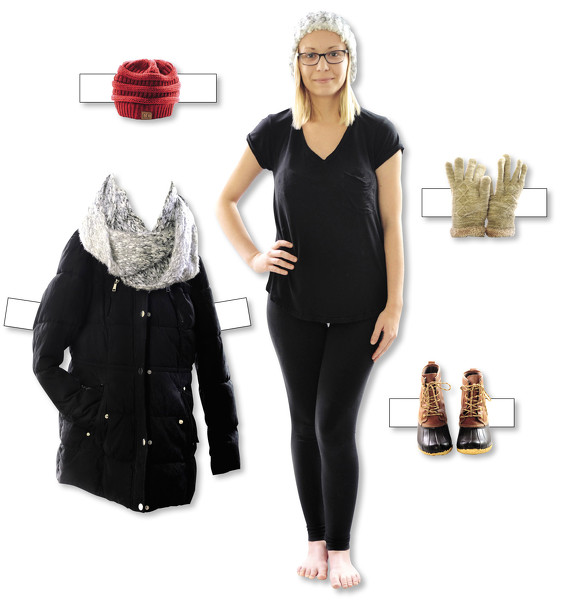Tuesday, November 26th, 2019
Dress in Layers
Experts advise bundling up to stay warm
By Leslie Gartrell

Photo by Dan Melograna/The Daily Standard
Experts advise bundling up to stay warm:
Hat: Buy a warm knit hat. The ones with a thermal lining are nice. Add a good scarf and face mask, too.
Gloves: The Mayo Clinic advises wearing a thin pair of glove liners under a pair of heavier gloves. But what is warmer than gloves? Mittens.
Long underwear: The first layer. The Centers for Disease Control and Prevention recommends fabrics that "hold body heat and don't absorb moisture."
Coat: The outside layer should protect the wearer from the elements.
Boots: The two Ws - Warm and waterproof. Also, a good fit is essential: you don't want blisters. Finally, you want something durable that won't break the bank.
Model: Ashlyn Stoltz
It's time to bundle up in layers to stay warm this winter season as temperatures continue to drop.
The Centers for Disease Control and Prevention advises staying as warm and dry as possible when venturing outdoors in cold weather. Adults and children should wear hats, scarves, mittens, sleeves that are snug at the wrist, a water-resistant coat and a pair of boots.
The CDC also recommends dressing in several layers of loose-fitting clothing. People should wear three layers - an inner layer, an insulation layer and an outer layer.
The inner layer should be made up of fabrics that will hold more body heat and don't absorb moisture, according to the CDC. Wool, silk or polypropylene will hold more body heat than cotton.
Can't Stop Running employee Melissa Sinning said wool socks will keep feet nice and cozy when out on a winter hike or run.
"It's a huge plus to have wool socks in the winter," she said.
She added that runners often will make sure they keep their hands and ears covered when running outdoors in the wintertime. Hats and gloves are a must-have, she said.
An insulation layer will help retain heat by trapping air close to the body, according to the CDC. Natural fibers such as wool, goose down or fleece work best.
Celina Tractor Supply Co. store manager Tyler Germann said fleece-lined jeans, jackets and coats are big sellers this time of year. Insulated flannels and sweatshirts also are in demand.
The outermost layer should protect from wind, rain and snow, according to the CDC. It should be tightly woven and preferably water and wind resistant to reduce loss of body heat.
So while a big puffy parka might seem like the coziest option, coats that feature an outer nylon shell can help buffer against wind and keep the wearer nice and dry if the weather turns wet.
Materials such as polyester and nylon are useful in extreme temperatures, Germann said. Sinning noted that nylon and polyester can wick away moisture and keep wind from chilling to the bone.
Layering also gives wearers the ability to remove different pieces of clothing if they start to get hot or sweat, which the CDC advises if people get too warm.


